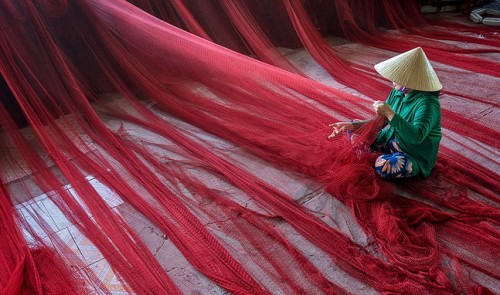A photo depicting a Vietnamese woman mending her fishing net was published in National Geographic’s Photo of the Day section last week and has since raised concerns among its readers over the net’s possible impact on ocean life.
Taken by Vietnamese photographer Pham Ty, the photo, named ‘Make and Mend,’ was released on March 8.
Ty’s photo describes a Mekong Delta woman checking a flow of fishing nets for damage, which, according to the photographer, “offers a glimpse into the daily routine of area fishermen.”
The photographer is humorously praised by his colleagues as the ‘god’ of fishing nets, after his other photo, ‘Sewing the Fishing Net,’ won the grand prize at the 12th Annual Smithsonian.com Photo Contest in 2014.
Amidst several compliments on the photo’s artistic value, some readers have expressed their concerns over the tightly sewn net featured in the photo, which could damage the aquatic ecosystem by catching all marine life on its path no matter how small it is.
Jen Mrsdoubleemm, a reader, wrote in the comment section ofNatGeo’s post on Facebook, “I can’t see this as beautiful. It is a sign of greed and destruction of the Oceanic ecosystem.”
“[This photo] may be beautiful in color but these nets haul in a lot of things they should not. [They are] dangerous to all sea life,” Lynne Stillwell, another reader, said.
Speaking to Tuoi Tre (Youth) newspaper on this matter, Ty said his award-winning photo, ‘Sewing the Fishing Net,’ met with similar reactions from the audience, though not as many as this one.
“National Geographic readers are very conscious of protecting the environment, so their reactions to my photo are perfectly understandable,” Ty said.
Responding to such concerns, the photographer posted on his Facebook timeline a status update on March 10 to call for specialists to help explain to foreign readers about the use of such nets in Vietnam’s traditional fishing industry.
“Some foreign readers are hesitant, concerned, or even critical of such a method of fishing for fear of the tightly knitted nets completely destroying marine life,” Ty wrote. “Maybe we could somehow explain to our friends that such nets are only used for catching schools of tiny fish such as anchovies…”
A Facebooker named Ngoc Thai answered the call, saying, “This is a type of polyethylene net made of plastic and rubber from Japan, which was first introduced into Vietnam in the 1980s. This type of net is used for catching aquatic mollusks such as clams, and some species of small fish like acetes [a genus of small, krill-like prawns] and anchovies, among others.”
“These nets are not used in many other countries for reasons such as climate patterns or technology,” Thai added.
Ty remains calm and receptive to all feedback, saying, “The artistic value of the photo and the reality of environmental protection are two different matters. However, I will take every feedback into serious consideration before officially answering National Geographic readers.”
























































